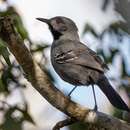Biology
provided by Arkive
The slender antbird is often seen on the ground, singly, in pairs or in family groups, searching for food. It moves deliberately with heavy hops and pauses to scan for prey, such as cockroaches, winged termites and spiders. It also rummages in leaf litter trapped amongst the leaves of large, terrestrial bromeliads. Pairs of slender antbirds appear to have small home ranges, up to 50 meters across, which are separated from those of other antbirds by 100 meters or more. Breeding is thought to begin in October, and decline between December and February with the onset of rains (2) (4).
Conservation
provided by Arkive
The slender antbird is protected by law in Brazil, and a project is underway by Birdlife International to study its breeding habitats and work with local communities and schools to raise awareness and understanding of this species. Establishment of a forest reserve within the antbird's range is urgently needed, to provide essential protection for this endangered bird (2) (3).
Description
provided by Arkive
This fairly large, grey antbird occurs in a small area of dry forest in Brazil. The male has ashy-grey plumage that is slightly paler on the underparts, with a distinctive black, triangular patch on the throat. The wings and the long, graduated tail are blackish-grey, and the wing feathers are finely edged in white. The female has paler underparts than the male and can also be distinguished by the russet colouring on the top of the head and back of the neck. The irises of this bird are bright red (2).
Habitat
provided by Arkive
The slender antbird inhabits hillside dry, deciduous forest with many lianas, (climbing, woody, tropical vines) and patches of bromeliads, between 100 and 1,000 meters (2) (3).
Range
provided by Arkive
Occurs in Brazil, in south-eastern Bahia and north-eastern Minas Gerais (2).
Status
provided by Arkive
Classified as Endangered (EN) on the IUCN Red List 2006 (1).
Threats
provided by Arkive
Whilst still fairly common within its habitat, the slender antbird has a very small range, and the population may be declining as a result of habitat loss. In 1990, only 5 – 20 percent of dry forest in east Bahia remained, having been steadily being cleared for cattle pastures, coffee plantations and firewood extraction (2). Much of the remaining forest is apparently unsuitable for the slender antbird due to a high level of disturbance by livestock (3).
Slender antbird
provided by wikipedia EN
The slender antbird (Rhopornis ardesiacus) is an endangered species of bird in the family Thamnophilidae. It is monotypic within the genus Rhopornis.[2] It is endemic to dry forest at altitudes of 100–1,000 metres (330–3,280 ft) in Bahia and Minas Gerais in Brazil. It is threatened by habitat loss. This relatively long-tailed antbird is about 19 centimetres (7.5 in) in length. Both sexes are grey with black-and-white markings on the wings and red eyes. The male has a black throat, while the female has a white throat and a brown crown.
References

- license
- cc-by-sa-3.0
- copyright
- Wikipedia authors and editors
Slender antbird: Brief Summary
provided by wikipedia EN
The slender antbird (Rhopornis ardesiacus) is an endangered species of bird in the family Thamnophilidae. It is monotypic within the genus Rhopornis. It is endemic to dry forest at altitudes of 100–1,000 metres (330–3,280 ft) in Bahia and Minas Gerais in Brazil. It is threatened by habitat loss. This relatively long-tailed antbird is about 19 centimetres (7.5 in) in length. Both sexes are grey with black-and-white markings on the wings and red eyes. The male has a black throat, while the female has a white throat and a brown crown.
- license
- cc-by-sa-3.0
- copyright
- Wikipedia authors and editors

